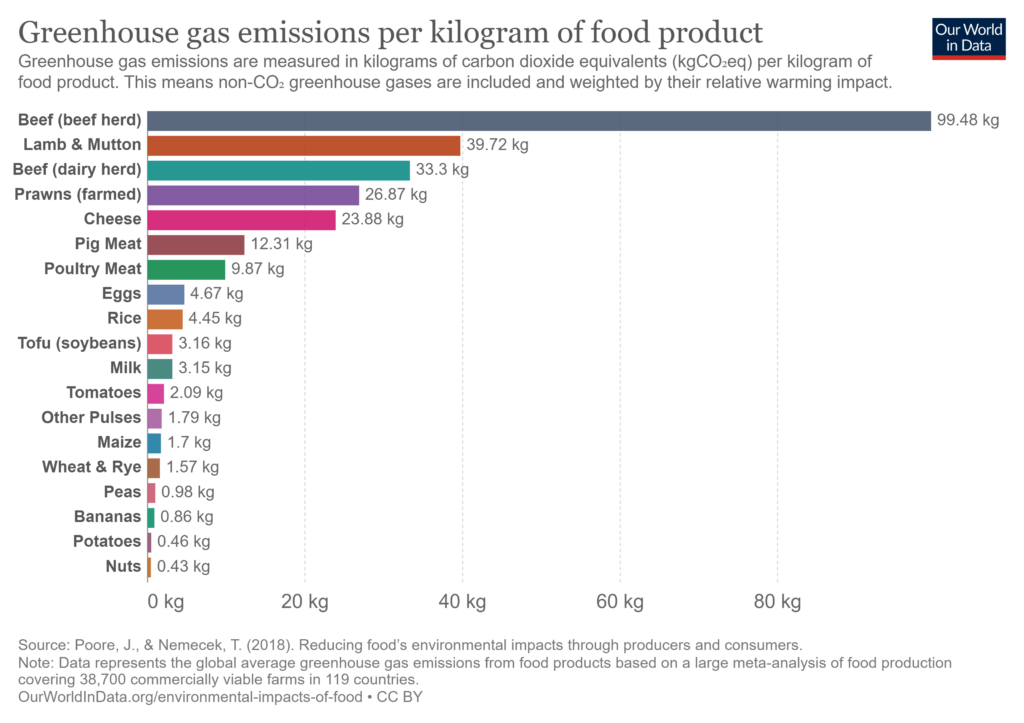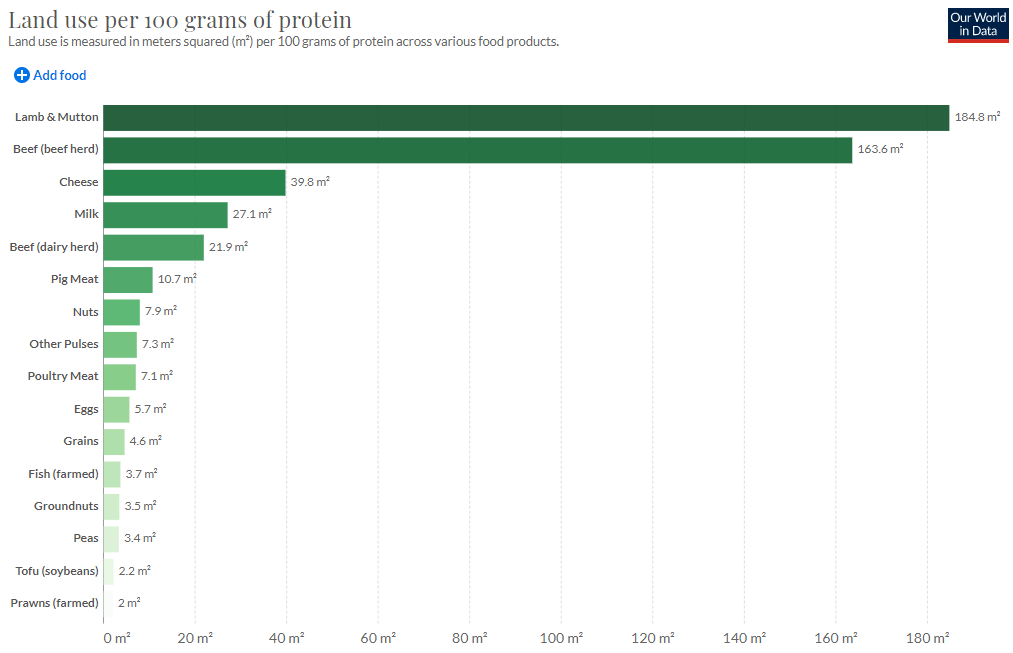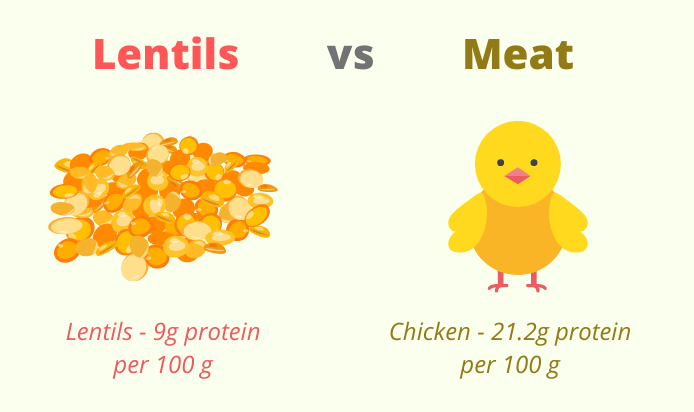Key takeaways:
- Even though lentils are a great plant-based protein source, most common meats have 2-3 times more protein per calorie.
- Meat is typically a complete protein, while lentils are not quite complete since they are low in the amino acid methionine.
- Lentils have significantly more vitamins and minerals overall.
- Lentils have a lower environmental impact than all meat sources, and it’s not even close.
Lentils are one of the best legumes when it comes to plant-based protein sources.
Additionally, it’s a natural substitute for meat like ground beef (in things like shepherd’s pie and rice dishes).
But while there are similarities, there are also some big differences in what you’re getting (nutritionally speaking) from lentils compared to meat.
I’ve gone over the main differences between lentils and popular types of meats (chicken, ground beef), so that you can get the answer to any questions you have. You can also see my vegan protein vs meat comparison for a more general comparison after.
Table of Contents
Do Lentils Have As Much Protein As Meat?
While it does depend on which cut of meat you’re looking at, in general, lentils only have about half as much protein as meat.
Lentils are good for a plant-based source of protein, but can’t really compare to most types of meat:
- 1 cup lentils (230 calories) – 17.9 grams protein
- 300 grams chicken breast (237 calories) – 50.4 grams protein
- 150 grams ground beef (321 calories) – 39.9 grams protein
On a per calorie basis, most types of meat will have significantly more protein than lentils.
While lentils are a decent protein source, it’s not surprising that chicken and ground beef have 2-3 times more protein per calorie.
Amino Acid Profiles of Lentils, Chicken, and Ground Beef
Because meat has so much more protein when we match serving sizes by calories, it makes sense to assume that it will also have more of each essential amino acid.
The data below confirms that guess:
| RDA | RDA | Lentils | Chicken Breast | Ground Beef (lean) | |
| mg per kg | for 70 kg person | 1 cup | 300 grams | 150 grams | |
| Calories | 230 | 237 | 321 | ||
| Tryptophan (mg) | 4 | 280 | 160 | 549 | 222 |
| Threonine (mg) | 15 | 1050 | 640 | 2,058 | 1,562 |
| Isoleucine (mg) | 20 | 1400 | 772 | 2,436 | 1,757 |
| Leucine (mg) | 39 | 2730 | 1,295 | 3,603 | 3,111 |
| Lysine (mg) | 30 | 2100 | 1247 | 4,005 | 3,317 |
| Methionine (mg) | 15 | 1050 | 152 | 1,311 | 1,041 |
| Phenylalanine (mg) | 25 | 1750 | 881 | 1,935 | 1,542 |
| Valine (mg) | 26 | 1820 | 887 | 2,418 | 1,958 |
| Histidine (mg) | 10 | 700 | 503 | 1,434 | 1,316 |
In one of our servings, each type of meat exceeded the recommended daily value for all essential amino acids (besides tryptophan for ground beef).
Considering it’s not rare to have more than one serving, the amino acid profile for either chicken or beef isn’t something you’d be worried about.
Lentils are a different story.
They still have a good amount of most amino acids. With just a few cups you’ll meet your daily value for most of them.
But like the amino acid profile for other legumes, lentils are low in methionine. If you are vegan, you want to make sure that you’re getting methionine from other plant sources (doesn’t necessarily have to be in the same meal though).
Most meats are complete proteins, meaning they have a solid amount of each essential amino acid. Legumes like lentils have a good profile, but are short on methionine, meaning that you wouldn’t want to solely rely on them for all your protein (although I’m not sure who would do that).
Lentils vs Meat: Which is Most Nutritious?
So, the protein isn’t really a comparison. Meat has more, and a better amino acid profile.
But nutritional value is a different story.
With the same serving sizes as above, I looked at the nutrients in each of the foods that were present in significant amounts.
Take a quick look at the data below:
| Lentils (%DV) | Chicken Breast (%DV) | Ground Beef (%DV) | |
|---|---|---|---|
| Fiber | 63% | 0% | 0% |
| Thiamin | 22% | 3% | 3% |
| Niacin | 10% | 51% | 39% |
| Vitamin B6 | 18% | 24% | 26% |
| Folate | 90% | 0% | 1.5% |
| Vitamin B12 | 0% | 3% | 63% |
| Iron | 37% | 6% | 24% |
| Magnesium | 18% | 6% | 7.5% |
| Phosphorus | 36% | 18% | 28.5% |
| Potassium | 21% | 6% | 13.5% |
| Zinc | 17% | 6% | 66% |
| Copper | 25% | 6% | 6% |
| Manganese | 49% | 6% | 1.5% |
| Selenium | 8% | 33% | 46.5% |
Lentils lead 9 of the 14 nutrients. While each meat source does have a decent amount of minerals, I still think it’s pretty clear that lentils are more well-rounded and nutritious.
I found the levels of zinc particularly interesting. The beef had the most by far, but lentils had much more than the chicken.
Not surprisingly, lentils are much more nutritious overall than either chicken or beef.
Environmental Impact of Lentils and Meat
At this point, it’s pretty common knowledge that a vegan diet is much better for the environment, but I’ll quickly outline why here.
Our World in Data has a lot of great data around this topic. The chart below shows the greenhouse gas emissions for a variety of different products.
Meat is the worst offender by far (although some like poultry is 10x better than beef), while lentils would fall under “other pulses” (1.79 kg of carbon dioxide equivalents).

Land use is a similar story where meat takes a lot more space to cultivate, even when you consider that factory farms stuff animals together in inhumane spaces.

Overall, there’s not really a question that lentils are much better in terms of environmental impact than meat (although some meat like poultry is better than others).
Summary: Are Lentils or Meat Healthier?
So where does this leave us.
- Meat has a lot more protein than lentils, but lentils still have a decent amount of protein (If you compare lentils vs black beans, lentils win that match up). It’s why vegan athletes typically base their diet on legumes like lentils and soybeans.
- When it comes to nutrients, lentils have more overall nutritional value.
- Lentils are much better for the environment than meat.
In addition, you need to consider other factors like saturated fat, which most meat has. It’s a controversial topic, but depending on where you land on it, that may push you towards saying that lentils are healthier. You’ll reach a similar conclusion when you look at comparisons like chickpeas vs chicken.
I’m not really trying to make a definitive conclusion about which is healthier, just to provide you with the nutritional data here in a clear way to help you plan your diet.
If you’re really looking for plant protein, you should see how seitan stacks up vs chicken, it’s pretty close.


Thank you so much for this nutrition layout! I am not vegan but I have made an effort to reduce eating meat by adding beans to meals or simply substituting it in completely. Literally all of the other sites one looks this up on are biased one way or the other which is irritating when you’d rather have all of the facts to make a decision for you and your family rather than someone elses interpretation of the facts (: Thank you for taking your time to make this. Have a great day!
No problem 🙂